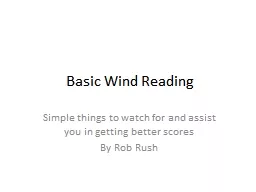

Simple things to watch for and assist you in getting better scores By Rob Rush The Perfect Shot The flight path of a projectile is influenced by a number of factors such as Bullet shape Ballistic Coefficient ID: 410105
Download Presentation The PPT/PDF document "Basic Wind Reading" is the property of its rightful owner. Permission is granted to download and print the materials on this web site for personal, non-commercial use only, and to display it on your personal computer provided you do not modify the materials and that you retain all copyright notices contained in the materials. By downloading content from our website, you accept the terms of this agreement.
Slide1
Basic Wind Reading
Simple things to watch for and assist you in getting better
scores
By Rob RushSlide2
The Perfect Shot
The flight path of a projectile is influenced by a number of factors such as;
Bullet shape ( Ballistic Coefficient)
Cross range winds
Atmospheric Conditions
Gravity
Distance to target
Muzzle Velocity
Accuracy of
discharged
shot
A good source of further reference for in depth information on these factors is available in reference books on target shooting and reloading or via bullet makers web sites such as the Sierra website;
http://www.exteriorballistics.com/
For those with modern phones you can also download the ballistics tables on a number of Apps as well.Slide3
Wind Reading 101
In simple terms the wind factors that will influence the projectile are:
Wind Speed
Wind Direction
How to measure speed.
For ease of reference shooters use 5 basic speeds which are:
Gentle (4 mph or 6kph)
Moderate (8 mph or 13kph)
Fresh (12 mph or 19kph)
Strong (16 mph or 25 kph)
Very Strong (20 mph or 32 kph)Slide4
Flag Patterns of wind speed
4mph.
8mph.
12mph
16mph.
20mphSlide5
Wind Direction Effects
Wind can vary in direction over 360 degrees
You only need to understand the effects of a 90 degree quadrant as these wind speed calculations can than be used for any direction of wind
For easy reference shooters refer to wind similar to the time on a clock face.
So a 3 o’clock wind has the same effect as a 9 o’clock wind just as a 7 o’clock wind has the same effect as its opposite a 1 o’clock wind
Wind speed effects on a bullet are NOT uniform at varying
angles i.e. a 45 degree angle does NOT equal a 50% wind effect
.
Wind Directions can impact on elevations as well.
At Ripley this is one of the important things that
shooters need to keep in mind due to the high incidence of fish tailing winds.Slide6
Wind Direction EffectsSlide7
Wind direction and grouping
You need to look for the predominate PATCH of wind to try and shoot in so that minimal impact is made to your groups.
Generally in a wind that is
“Fresh
and
above”
and blowing up range its best to watch the flags closest to the targets
In a
“Fresh wind and
above” blowing down range its best to watch the flags closest to the shooters.For Cross winds and winds angling between 30 degrees and 90 degrees its better to watch the flags closest to the shooter
On some ranges like Ripley with it gullies and ridges you may need to add and subtract wind readings due to cross winds i.e. the flags at the firing point may be going one way whilst those at the butts are opposite. You need to break the range up into its component parts and go with the net wind result. It is easier to get better scores in squarer winds than fishtailing winds due to this effect that directional changes can have on groupsSlide8
Wind direction and grouping
Grouping in squarer winds is easier due to the impact of only
1/10
th
wind
variation required between 65 degrees and 90 degreesSlide9
Wind direction and grouping
Grouping in
fishtailing winds
is
harder
due to the impact of
up to
9/10
th wind variation required between 0 degrees and 65
degreesSlide10
Rules of Thumb
On all targets the scoring rings up to the 4 line are generally at ½ minute increments from centre on all ranges
So the V bull is ½ minute from centre to bull line
The Bull is ½ minute from v to 4 line
The total bullseye is about 2 minutes across
The 4 line is about another ½ minute to the 3 line
But all minutes are not the same. Just to confuse us when most
TR
shooters using a CENTRAL sight and other
TR
shooters talk minutes they may have
different calibrations on the sights.The Australian Central sight requires an extra 22% adjustment to the minutes that English Sights (and their
plotting tables) produce. So be careful when comparing notes with others.
I now have both English and Australian Central sights in use and to adjust I think of my English ¼’s as 1/3’s in Australian adjustments.
There are easy to use wind charts readily available and are a good reference point when you get a little lost in the wind. I still take my tables down with me sometimes in big winds for a little security.